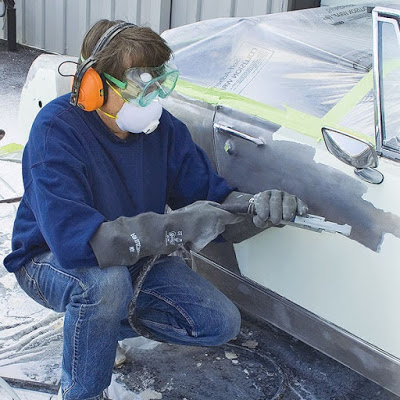 In the old days, one would use a “sand blaster” to expose the raw base material if finding themselves needing to clean up some parts before painting a car. Today, people use a similar technique called “media blasting.”
In the old days, one would use a “sand blaster” to expose the raw base material if finding themselves needing to clean up some parts before painting a car. Today, people use a similar technique called “media blasting.”
About the substance used
Walnut shells are quite cheap and eco-friendly but only last for one use. Plastic beads may be used many times. Both of these things are gentle enough to strip paint on metal, although they are not abrasive enough to remove rust. To remove rust, aluminum oxide is the best to use. Not only will it strip off all the paint and rust, it will even smooth out minor gouges and scratches. The best part of the aluminum oxide media is that it may be used over and over.
What one can clean
Media blasting is very good for cleaning the rust off metal parts and has been used for years to do just that. Today, you may even clean up plastic, wood and other materials with a media blaster. As you can imagine, a media blaster is the dream of many car owners.
How media blasters work
Media blasters use pressurized air to shoot small pieces of material (media) out of a nozzle to strip off the surface covering of a component. It’s sort of like pressure washing, only at lower pressures and it does not use water, it uses just the media and air. The most commonly used media include plastic beads, ground-up walnut shells, glass beads and aluminum oxide.
Kinds of media blasters you may buy
Usually, media blasters are boxes with an internal blasting gun and a pair of heavy-duty gloves built into their structures. The smaller ones cost about $200 not including an air compressor. Large standing cabinet blasters with about many cubic feet of internal space cost more – usually around $600 and up. The media generally cost less than $50 for a five- gallon bucket, but many media may be reused repeatedly for a long time. The typical specification for the compressor used with media blasters is that it can handle a minimum of 80 psi at 5 cubic feet per minute.
How media blasting is done
A rule to go by for media blasting is to use the lightest abrasive and lowest pressure needed to begin. Don’t forget that the softer your target material, the gentler you should be. It’s always a good idea to test your material and pressure setting first on a section of the component that is not seen. If it takes off the surface covering quickly then you’re all set. If it’s slow going, then you need to step up your air pressure. And if you’re wondering, the technique used in the olden days was changed to the one people presently use because of the health risks of inhaling silica particles from sand.
Thank you to the Sales team at Antioch, a full-service Chrysler, Dodge, Jeep and RAM car dealership in Antioch, IL for discussing media blasting with us!

